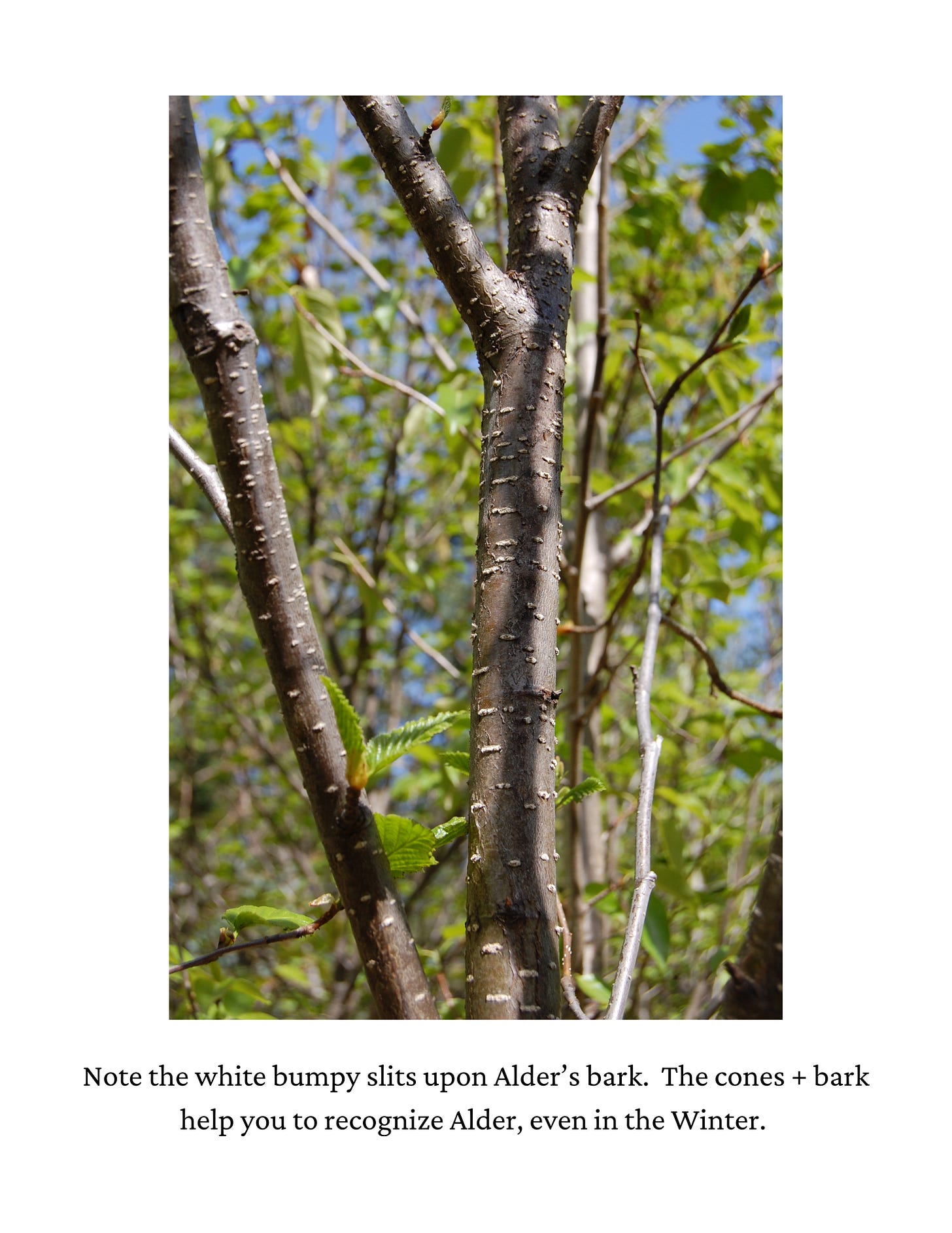✦ 9 Plants you can Chew up & Use on a Bug Bite ✦
Alder, Chickweed, Comfrey, Mallow, Mint, Plantain, Violet, Wormwood & Yarrow
^^ It’s really helpful to know which Plants you can readily use to help reduce swelling, itching and more while out in the woods or in the garden! Here we have Cleavers which I used on multiple mosquito bites one Spring day…the following is an excerpt from June’s edition of Haven Making: Using Plant Magic to Create Sanctuary.
Thank you so much for reading & subscribing. And an extra big thank you to my paid subscribers!! It means so much to have my work with the Plants supported — This one’s for you :)
Alder
(Alnus sp.)
I don’t recall Alders while growing up, it was in Alaska where we became acquainted. Those dense thickets near waterways that could hide nearby bears if you weren’t mindful. In the Spring, the flowers would droop off the ends of branches, glimmering golden-green. In Autumn, the little Alder cones could double for Pine cones in a fairy house. Fast growing, and nitrogen fixing, Alders are considered a pioneer-species. They come in, especially growing where their roots can be damp, and shore up sandy banks, providing shade, and later leaf debris help the Cottonwoods that often follow.
It was around 2011 or so when I realized that Alder leaves could be helpful in easing a bug bite. My son and I were down at 7 Pastures, near the Skagway River, walking Clover & Steiner, our dogs at the time. It was late in the summer, and as we made our way over the cobbled river rock, I was bit by the dreaded White Socks fly. Those buggers can raise a welt faster than a bee sting at times.
The White Socks fly is named as such because it has a white line on its two front legs, a ‘sock’. The first best thing to do after you’ve been bit, is to NOT ITCH IT. This is challenging and also goes for most itchy bug bites. Main-stream medicine would say that: when you’re bit, the body releases histamine, a compound that helps white blood cells get to the affected area. Histamine causes the itch, the inflammation, and swelling. Alternatively, you could also be reacting to the invasion of your body by the insect—GNM indicating a biological shock due to the penetration by a foreign body or substance…
Of course, you’re more than welcome to scratch away, but I’ve found the bite often becomes far worse if scratched relentlessly.
Back to that walk. I itched before I realized what had got me. There’s a particular way that White Socks bites present, looks like someone took the tip of a fine red Sharpie and dotted the middle of a mosquito bite—which I then noticed on my forearm. Some folks swell up so badly they are incapacitated and can’t work for a day or more.
There was not Yarrow, nor Plantain in the immediate vicinity, but there were a lot of Alders growing in those rocks. I knew Alder leaves to be astringent and antiseptic, so I extrapolated that they would also be helpful for this situation. I took a few leaves, chewed them up until I could taste it (no, they don’t taste good), and placed the gooey pulp on my arm.
Within minutes the pain, swelling and itch factor was reduced to a manageable rate. I thanked the Alders for their medicine and thanked that fly for its role in expanding my Plant Knowledge toolbox.
Sidenote: When I was pregnant with my daughter, one of the boy names I considered, was Alder. We had chosen to use a birth center (a story for another time & place) and we were blessed with seeing the vibrant Lupines blooming during that time. Lupine became a possible girl name…
During the birthing process, I was walking around outside. It was close to midnight, and my partner and I were walking on the sidewalk in front of the birth center entrance. At one point I had to stop as a sensation intensified, and I zoned in on the plantings there flanking the entrance. Right away I keyed in on a Lupine flower! It’s a girl! I thought. And right after I thought that, my attention focused in on a rouge Alder tree. OR, maybe it’s a boy!
Plants have a sense of humor I’ve found…




